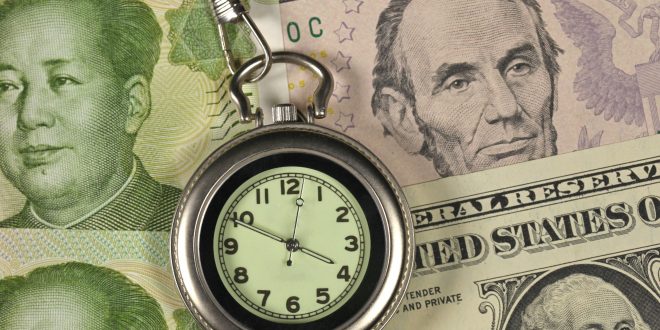In the third week of April, the main market movers were concerns about the resurgence of the coronavirus pandemic especially in Asia, as well as economic data, most of which signaled recovery from the negative impacts of the coronavirus in the United States, Eurozone, and China.
In addition, media reports indicating that U.S. President Joe Biden plans to propose a tax increase on capital gains negatively reflected on equity markets.
Japan, which is facing difficulties to contain a new spike in Coronavirus infections, plans to declare a “short and strong” state of emergency in Tokyo and other large cities from April 25 to May 11. The government will require restaurants, bars and karaoke lounges that serve alcohol to close, and major sporting events to be held without an audience.
Dollar
The U.S. Dollar (USD) declined across the board, due to the decline in Treasury bond yields. The Dollar Index (DXY), which measures the greenback’s performance against a basket of six major international currencies, fell by around 0.8% by the end of the week to finish at 90.83, its lowest closing level since March 2.
The benchmark 10-year Treasury bond yield increased by 1.2 basis points to 1.566%, declining by about 0.5 basis points for the week. The return on the 30-year bond leveled up by 1.1 basis points to 2.251%, limiting its weekly decline to roughly 0.9 basis points. Meanwhile, the 2-year bond yield went up by 0.6 basis points to 0.157%, losing 0.6 basis points on a weekly basis.
Euro
The Euro (EUR) surged last week, finishing at its highest level against the USD in since February 25, with the EUR/USD pair gaining about 0.94%.
The European currency was supported by a more hawkish tone by the some board members European Central Bank (ECB), which maintained interest rates unchanged during its policy meeting on Thursday. The ECB is now expected to reduce its massive pandemic emergency purchase program (PEPP) later this year.
However, gains were limited as ECB President Christine Lagarde refuted expectations that policymakers would begin to consider reducing bond purchases due to the improved economic outlook.
The preliminary reading of the Eurozone IHS Markit PMI, which is considered a good indicator of the resilience of the economy, rose to a nine-month high of 53.7 from 53.2 in March.
Sterling
The British Pound (GBP) limited its weekly gains against the USD, with the GBP/USD closing the week at 1.3876, rising by about 0.32%, way below its highest closing level for the week, which it registered on Monday at 1.3986.
Inflation in the UK inflation rose to 0.7% in March from 0.4% in February, due to higher fuel and clothing prices, slightly below the average forecast of 0.8% in a Reuters poll of economists.
British inflation is expected to rise sharply in the coming months, due to an increase in household regulated energy bills in April, and the rise in global oil prices and the comparison with prices a year ago when the lockdown measures to combat the Coronavirus pandemic caused a decline in demand.
Last month, the Bank of England (BoE) expected inflation would reach 1.9% by the end of 2021, but many economists now expect it will exceed the 2% target before that time.
Furthermore, official figures showed that the unemployment rate in the UK unexpectedly decreased for the second month in a row to 4.9%, during the period from December to February, most of which were under strict isolation measures to confront the outbreak of the pandemic.
Stocks
Most of Asian stock markets, except for China, declined on the back of selling pressures from foreign investors who withdrew around $2.5 billion.
Meanwhile, the European stocks recorded their first weekly loss in eight weeks, with the pan-European STOXX 600 index losing 0.8% for the week.
Similarly, the New York Stock Exchange (NYSE) registered losses, despite a rebound in the last session of the week on the back of positive economic data.
The Dow Jones Industrial Average closed at 34,043.49 points, recording a weekly decline of 0.5%. Meanwhile, the S&P 500 index finished at 4,180.17 points, losing 0.1% for the week. As for the Nasdaq Composite Index, it ended the week at 14,016.81 points, losing 0.3% on a weekly basis.
Gold
Gold turned to a weekly loss by the end of the week, despite the fall of the USD. The prospects for economic recovery, as evident by recent economic data, reduced demand for safe havens and led to better risk appetite.
Gold futures for June delivery finished the week lower by about 0.1% at $1,777.80 per ounce.
Throughout the week, the yellow metal received support from higher demand for safe haven assets, due to concerns about the resurgence of the coronavirus pandemic with a new wave of infections.
Oil
Oil prices limited their weekly losses by rising on Friday. The losses resulted mostly because of concerns about demand recovery amid a resurgence of the coronavirus with a rising number of new cases, especially in India.
Brent crude futures for June delivery, the global benchmark, posted a weekly decline of 1%. Meanwhile, the U.S. West Texas Intermediate (WTI) June futures lost 1.7% for the week.
Since the beginning of the year, both the global and U.S. benchmark crude most active contracts gained about 27%, on the back of expectations for demand recovery in the second half of the year.
Furthermore, the number of active rigs drilling for crude oil in the United States declined this week, for the first time since March, despite rising oil prices encouraging a rise in production. Oil rigs decreased by a single rig to reach 343, while natural gas rigs maintained their level of last week at 94, according to data by Baker Hughes. Accordingly, the total rig count reached 438 for the week ended 23 April.
 Noor Trends News, Technical Analysis, Educational Tools and Recommendations
Noor Trends News, Technical Analysis, Educational Tools and Recommendations





